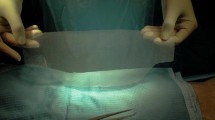Abstract
Recurrence rate is the utmost outcome parameter in determining the clinical effectiveness of any hernia surgery. Between June 1999 and September 2004, six patients presented with recurrent hernia after endoscopic totally extraperitoneal inguinal hernioplasty (TEP). Four of the six recurrences (67%) occurred within a few months after TEP, indicating a technical failure. Of the 1,093 TEPs performed by the author, a total of three patients developed recurrence, giving an overall recurrence rate of 0.27%. All six patients underwent open Lichtenstein hernioplasty. Intraoperative findings showed recurrent indirect inguinal hernia in all patients. Half of the recurrence (n=3) was due to a sliding lipoma without a peritoneal hernial sac. Untreated herniated retroperitoneal adipose tissue into the internal inguinal ring during initial TEP constitutes the leading cause of recurrence after TEP. Routine exploration of internal ring for any herniated retroperitoneal adipose tissue during TEP is recommended. Herniated retroperitoneal adipose tissue should be resected whenever feasible.
Similar content being viewed by others
References
Kumar S, Nixon SJ, MacIntyre IM (1999) Laparoscopic or Lichtenstein repair for recurrent inguinal hernia: one unit’s experience. J R Coll Surg Edinb 5:301–302
Liem MS, van der Graaf Y, van Steensel CJ et al (1997) Comparison of conventional anterior surgery and laparoscopic surgery for inguinal hernia repair. N Engl J Med 336:1541–1547
Ferzli GS, Shapiro K, DeTurris SV et al (2004) Totally extraperitoneal (TEP) hernia repair after an original TEP. Is it safe, and is it even possible? Surg Endosc 18:526–528
Knook MT, Weidema WF, Stassen LP et al (1999) Laparoscopic repair of recurrent inguinal hernias after endoscopic herniorrhaphy. Surg Endosc 13:1145–1147
Rutkow IM (1995) The recurrence rate in hernia surgery. How important is it? Arch Surg 130:575–576
Lau H, Patil NG, Yuen WK (2006) Day-case endoscopic totally extraperitoneal inguinal hernioplasty versus open Lichtenstein hernioplasty for unilateral primary inguinal hernia in males: a randomized trial. Surg Endosc 20:76–81
Tamme C, Scheidbach H, Hampe C et al (2003) Totally extraperitoneal endoscopic inguinal hernia repair (TEP). Surg Endosc 17:190–195
Liem MS, van Duyn EB, van der Graaf Y et al (2003) Recurrences after conventional anterior and laparoscopic inguinal hernia repair: a randomized comparison. Ann Surg 237:136–141
Wright D, Paterson C, Scott N et al (2002) Five-year follow-up of patients undergoing laparoscopic or open groin hernia repair: a randomized controlled trial. Ann Surg 235:333–337
Ramshaw B, Schuler FW, Jones HB et al (2001) Laparoscopic inguinal hernia repair. Lessons learned after 1224 consecutive cases. Surg Endosc 15:50–54
Aeberhard P, Klaiber C, Meyenberg A et al (1999) Prospective audit of laparoscopic totally extraperitoneal inguinal hernia repair: a multicenter study of the Swiss Association for Laparoscopic and Thoracoscopic Surgery (SALTC). Surg Endosc 13:1115–1120
Phillips EH, Rosenthal R, Fallas M et al (1995) Reasons for early recurrence following laparoscopic hernioplasty. Surg Endosc 9:140–145
Felix E, Scott S, Craftton B et al (1998) Causes of recurrence after laparoscopic hernioplasty. A multicenter study. Surg Endsoc 12:226–231
Leibl BJ, Schmedt CG, Kraft K et al (2000) Recurrence after endoscopic transperitoneal hernia repair (TAPP): causes, reparative techniques, and results of the reoperation. J Am Coll Surg 190:651–655
Lowham AS, Filipi CJ, Fitzgibbons RJ Jr et al (1997) Mechanisms of hernia recurrence after preperitoneal mesh repair. Traditional and laparoscopic. Ann Surg 225:422–431
Lau H, Patil NG, Yuen WK et al (2002) Learning curve for unilateral endoscopic totally extraperitoneal inguinal hernioplasty. Surg Endosc 16:1724–1728
Deans GT, Wilson MS, Royston CM et al (1995) Recurrent inguinal hernia after laparoscopic repair: possible cause and prevention. Br J Surg 82:539–541
Lau H (2004) Sliding lipoma: an indirect inguinal hernia without a peritoneal sac. J Laparoendosc Adv Surg Tech A 14:57–59
Gersin KS, Heniford BT, Garcia-Ruiz A et al (1999) Missed lipoma of the spermatic cord. A pitfall of transabdominal preperitoneal laparoscopic hernia repair. Surg Endosc 13:585–587
Lilly MC, Arregui ME (2002) Lipomas of the cord and round ligament. Ann Surg 235:586–590
Lau H (2004) Endoscopic totally extraperitoneal inguinal hernioplasty for recurrence after open repair. ANZ J Surg 74:877–880
Dion YM, Laplante R, Charara J et al (1994) The influence of the number of endoclips and of mesh incorporation on the strength of an experimental hernia patch repair. Surg Endosc 8:1324–1328
Hollinsky C, Gobl S (1999) Bursting strength evaluation after different types of mesh fixation in laparoscopic herniorrhaphy. Surg Endosc 13:958–961
Choy C, Shapiro K, Patel S et al (2004) Investigating a possible cause of mesh migration during totally extraperitoneal (TEP) repair. Surg Endosc 18:523–525
Klinge U, Klosterhalfen B, Muller M et al (1998) Shrinking of polypropylene mesh in vivo: an experimental study in dogs. Eur J Surg 164:965–969
Coda A, Bendavid R, Botto-Micca F et al (2003) Structural alterations of prosthetic meshes in humans. Hernia 7:29–34
Acknowledgments
The author wishes to acknowledge the kind assistance of Tze-Ching Tan, FRCS, in editing the manuscript.
Author information
Authors and Affiliations
Corresponding author
Rights and permissions
About this article
Cite this article
Lau, H. Recurrence following endoscopic extraperitoneal inguinal hernioplasty. Hernia 11, 415–418 (2007). https://doi.org/10.1007/s10029-007-0246-z
Received:
Accepted:
Published:
Issue Date:
DOI: https://doi.org/10.1007/s10029-007-0246-z




